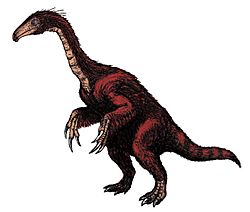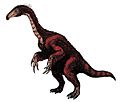Segnosaurus facts for kids
Quick facts for kids SegnosaurusTemporal range: Upper Cretaceous
|
|
|---|---|
 |
|
| Segnosaurus | |
| Scientific classification | |
| Kingdom: | |
| Class: | |
| Superorder: | |
| Order: | |
| Suborder: | |
| Family: | |
| Genus: |
Segnosaurus
|
Segnosaurus (which means "slow lizard") was a plant-eating theropod dinosaur. It lived during the late Upper Cretaceous period, about 93 million years ago. This makes it one of the dinosaurs that lived closer to the end of the dinosaur age.
Segnosaurus was a pretty big Therizinosaur. Therizinosaurs are a special group of theropod dinosaurs. Most theropods were meat-eaters, like T. rex. But therizinosaurs, including Segnosaurus, changed their diet and became plant-eaters!
What Segnosaurus Looked Like
Scientists have found four parts of Segnosaurus skeletons in Mongolia. These fossils help us understand what this unique dinosaur looked like.
Segnosaurus had a long, flexible neck, which might have helped it reach leaves high up in trees. It also had a long head. Its feet had three toes, and its legs were strong and stocky. It had claws on its fingers and toes.
This dinosaur also had a wide, strong pelvis (hip area) and a short tail. In 2010, a scientist named Gregory Paul guessed that Segnosaurus was about six meters (about 20 feet) long. He also thought it weighed around 1.3 tonnes (about 2,800 pounds). That's as heavy as a small car!
Where Segnosaurus Lived
The fossils of Segnosaurus were discovered in Mongolia, a country in Asia. They were found in rocks from the Upper Cretaceous period. This tells us that Segnosaurus roamed the lands of ancient Mongolia.
Many other interesting dinosaurs and creatures lived in the same area during that time. Scientists continue to study these fossil sites to learn more about the ancient world.
Images for kids
-
A cast of a huge claw from Therizinosaurus, a relative of Segnosaurus.
-
A reconstructed skeleton of Alxasaurus, which helped scientists understand therizinosaurs better.
-
Part of the arm of Beipiaosaurus, a therizinosaur that had feather-like structures.
See also
 In Spanish: Segnosaurus galbinensis para niños
In Spanish: Segnosaurus galbinensis para niños














